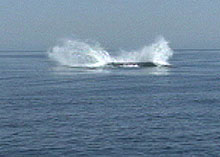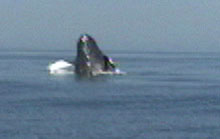Olympic Coast National Marine Sanctuary
Tailing The Whales
June 14, 2002
Robert Steelquist
Olympic Coast National Marine Sanctuary
The onset of summer months on the Olympic Coast brings a host of migrants. Long days and northerly winds create perfect conditions for a burst of productivity in the temperate coastal waters. As surface water is driven offshore by winds from the north, cold, nutrient-rich water flows up to take its place. In the sunlit shallows, nutrients from the bottom feed vast clouds of microscopic plankton, which, in turn, feed larger organisms. By mid summer, the entire ecosystem is generating a phenomenal amount of biomass—organisms smaller than the eye can see, whales, and everything that eats or gets eaten by something else in between.
We're here to observe part of that burst. Every summer, Olympic Coast National Marine Sanctuary attracts humpbacks, some that winter off Mexico, and some in Hawaii, migrating up the Pacific coast to Washington and British Columbia.
From high on the flying bridge of the McArthur, Annie Douglas of Cascadia Research and Barry Troutman of the Washington Department of Fish and Wildlife are counting whales. From this vantage, the horizon circles us 6.8 miles away in all directions. Humpback whales appear as minute puffs (their spouts) or as fleeting black objects or distant splashes.
In order to sample marine wildlife systematically, researchers have designed transects—long lines that run east to west which are spaced about 5 miles apart. Cruising at 10 knots, the ship motors along the line while the observers carefully note whales that are visible.
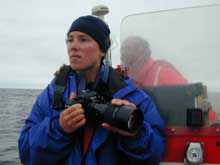
Annie Douglas of Cascadia Research trails a humpback from the chase boat. (Photo: Robert Steelquist) Click image for larger view.
Occasionally, as whales are spotted, the McArthur stops, and lowers a small boat so that Annie can get a closer look and take photographs of the humpback whale's distinctive fluke (tail) coloration and shape. Whale identification has been an ongoing project for over 20 years by several agencies and research organizations, including Cascadia Research, based in Olympia, Washington. Annie has been working on whale ID projects since 1995, when she was a student at The Evergreen State College. Since then, she has worked with humpbacks, blues, orcas, and gray whales in California, Washington, Costa Rica and the eastern tropical Pacific.
The skiff runs at 25 knots, pounding through swells and slowing to a crawl as it nears a whale. As the whale surfaces, it exhales in a loud rush of air. Immediately, you are overcome with its foul-smelling breath. We position the boat in the whale's wake, following the smooth “footprints” on the water surface.
On a productive search, we encounter 8 or 9 whales, some in pairs or threesomes. Calm animals continue traveling in one direction. A spooked whale may abruptly change course. We try to maneuver gently, to minimize the disturbance as much as possible. It can seem like an odd cat and mouse game, trying to anticipate the next move of a giant, who moves so effortlessly in three dimensions while we are limited to two. These whales seem particularly wary. With these humpbacks “It's expected,” she says, “In some areas where there are lots of whales, I don't get too stressed about it, but in places like this where you have low densities, I really try to get every photo possible.”
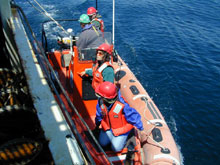
When whales are sighted, the crew quickly lowers a chase boat to get whale fluke identification photos. (Photo: Robert Steelquist) Click image for larger view.
Annie positions herself in the bow of the boat, ready to take a quick photo if the whale raises its flukes. A few yards ahead, the whale sounds, its gasp filling the air and its twin blowholes flared open. The massive, glistening back arcs away from us. The fullness of its ribs circle away from its spine. We see the small dorsal knob and wait, hoping the whale will arch downward and flip its tail up.
Quickly aiming her Nikon camera with a 400mm lens, she pauses to catch the fluke markings. Good shots mean that another humpback “fingerprint” goes into a catalogue of 1000 photos that researchers have been accumulating for the last 20 years. More often than not, the whale simply dives without showing its tail, coaxing us to trail it further away from the ship.
We get lucky on 5 whales. Stalking patiently behind, we see the telltale arch of the body that indicates a deep dive. The broad black flukes rise slowly, with streams of water pouring off the ruffled edge. With an easy flip, the lower surface shows the distinctive white and black markings that are this whale's unique identifier. Once she's back on land, Annie will compare this year's whale identification photos with those of previous years, and learn which humpbacks are returnees to the Olympic Coast.
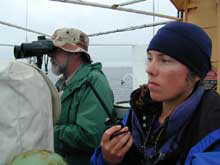
Barry Troutman and Annie Douglas search for whales from McArthur's flying bridge. (Photo: Robert Steelquist) Click image for larger view.
Studying these whales is important to Annie. “Basically, humans know so little about these animals and we've done so much to their populations, we owe it to them to know where they are going and to know what areas they are using, so we can protect those areas.”
Back onboard the ship Barry is keeping tabs just on numbers, not fluke markings. He has studied marine mammals since 1981 and been a participant in four previous Olympic Coast National Marine Sanctuary McArthur cruises. In his survey method, he observes the entire 180 degrees in front of the ship, from starboard to port beams, and almost 7 miles in the distance. The challenge of seeing every whale within 13 miles is daunting, but Barry's eyes are well trained.
“Its not so much the eyesight as the patience,” he explains. “This job requires you to be very alert, but very relaxed at the same time. Its trying to find some kind of balance between being alert, trying to detect things that pop out of the background—like a blow in the distance or a body—and yet at the same time stay relaxed enough so that you can make it through an entire day.”
Whale sightings are going well on this cruise, according to Barry. “This is a lot of humpback whales. I'd have to check my records, but this is probably more than we've had on previous cruises. Anytime you find concentrations of something like humpback whales, that's got to tell you something about the richness of the ecosystem that's supporting them.”
Barry sees great value in this year's Sanctuary Quest cruise as a continuation of previous McArthur marine mammal surveys. “Prior to the McArthur cruises, really our knowledge of what was out here pretty much stopped a mile or two or three offshore, and beyond that, we knew there were whales, but there wasn't very much information. As a biologist I'm interested in that because it's a big piece of the picture that we didn't have.”


























